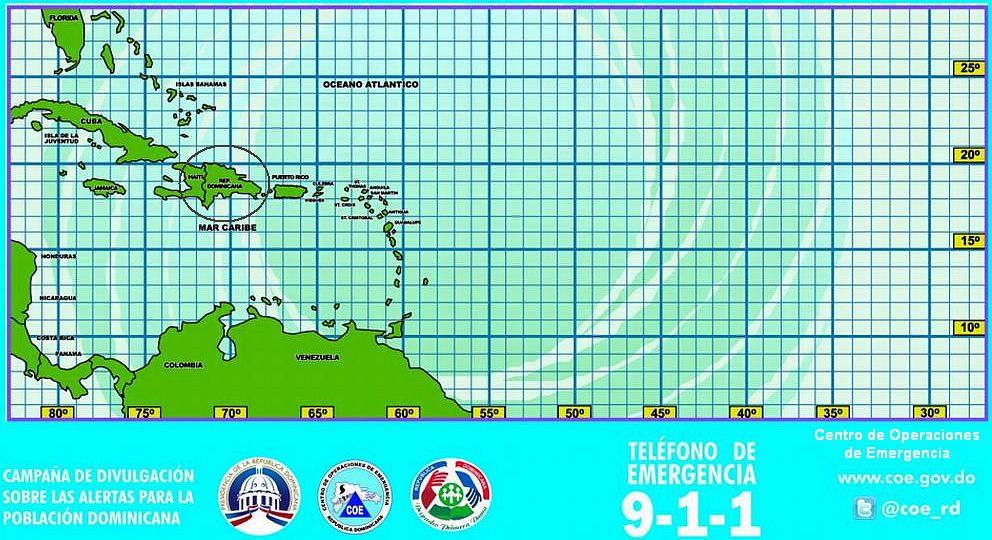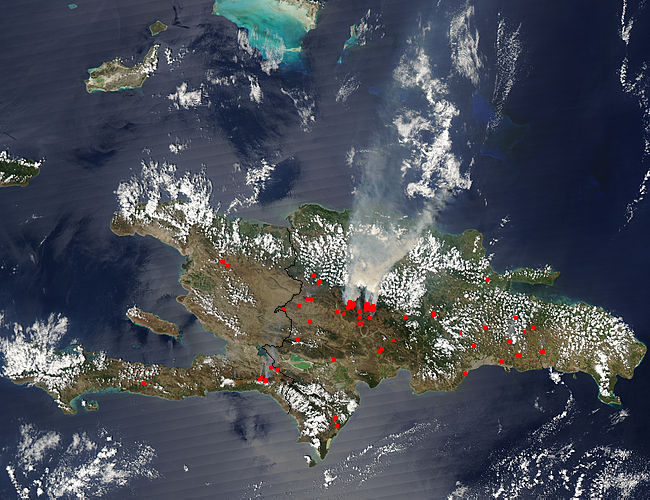Earthquake / Terremotos / Temblor de Tierra Information for
Dominican Republic
Earthquakes / los Terremotos/ Temblor de Tierra
Yes, we do have earthquakes in Dominican Republic. We call an Earthquake in Spanish a Terremoto or Temblor de Tierra. Whatever you want to call them we do have this earth-shaking phenomenon occurring here on our island and we do have many earthquakes. The island of Hispaniola does have seismic activity almost daily, as with many places throughout the world, but the activity is so small that usually it cannot be felt. Every so often the quakes are strong and they can be felt. You can feel the earth move and sway under your feet!
Fault Lines | Fault Line Map | What to Do | Largest Quakes in Dominican Republic | The Quake Sept. 2003 | Recommended Emergency Products | Links to Earthquake Related Web Sites
The island of Hispaniola, part of the Greater Antilles chain of islands, rose out of the sea due to volcanic action. Dominican Republic has a long history of volcanic and seismic activity. The tallest mountain on the island, and for that matter in all of the Caribbean, is Pico Duarte. This mountain was at one time an active volcano. It rose out of the sea starting with this mountain and it is still rising. Many of the under water caves are not under water now. Don’t worry about Volcanoes for now. There are no active volcanos on our island.
Fault Lines
There are two major fault systems or lines that run through the island. In the North Hispaniola Trench. It is located just offshore running parallel to the north coast. The other is the Septentrional Fault Zone which runs from the North Hispaniola Trench to the Cibao Valley and Santiago. The Septentrional Fault Zone is responsible for most of the earthquakes in Dominican Republic’s history.
View a PDF document of the fault lines going through Dominican Republic by www.ig.utexas.edu
The Puerto Rico Trench (on the Northern side of Puerto Rico and the Northeast tip of Dominican Republic), which is close to the Mona Passage, marks a boundary where the North American tectonic plate and the Caribbean tectonic plate slide past each other, with the North American plate also subducting or sliding beneath the Caribbean plate. With water depths of more than 8 km (5 mi) make the Puerto Rico Trench the deepest part in the entire Atlantic Ocean.(see the map and learn more)
The Mona Passage is the water pass that divides Puerto Rico and the Dominican Republic in the northeastern Caribbean. This area is very earthquake prone. Since the water level in this passage between the two islands is quite low it is very susceptible to Tsunamis. This passage has very fast flowing and dangerous waters with shifting currents that occur when the Atlantic Ocean and the Caribbean Sea meet.
http://soundwaves.usgs.gov/2007/05/
Fault Lines / Fallas Sísmicas

There are also many smaller fault lines/ fallas sísmicas running through the island of Hispaniola. This is a map from Emergency Operations Center (COE) showing all the lines running through Dominican Republic and Haiti.
Brochures – What To Do
Below are the instructional brochures put out by the Emergency Operations Center about what to do before and after an Earthquake happens. They are in Spanish. Click on the images to see the images to enlarge.
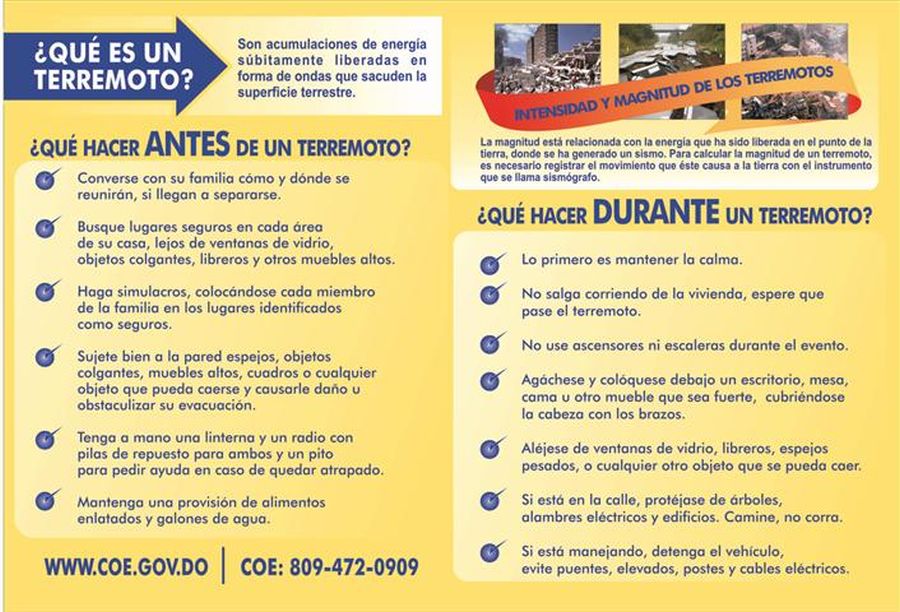
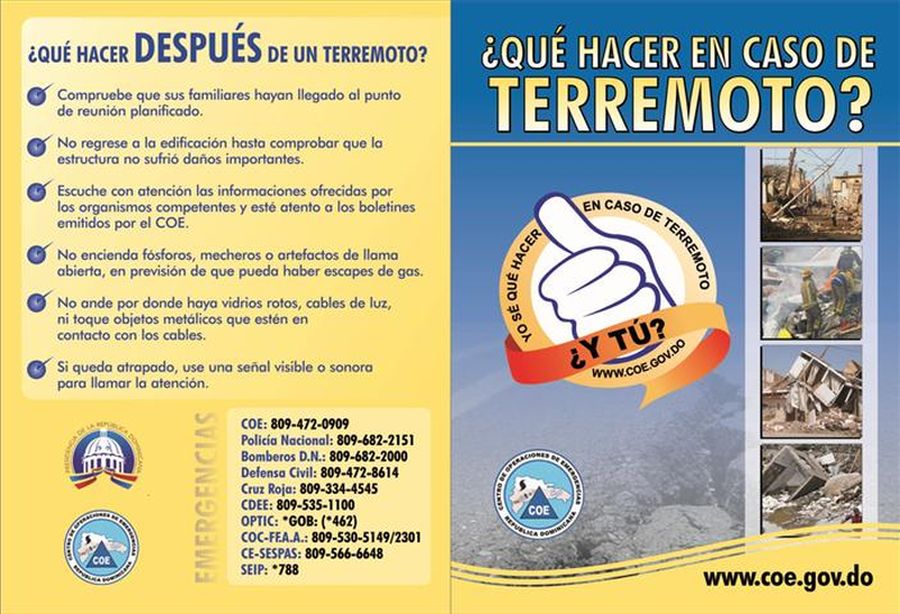
Many people say many different things one needs to do to be safe during an earthquake. Stand in a doorway, don’t stand in a doorway. Don’t go outside, get outside and away from buildings. Get under something inside your house, get in the “Triangle of Life” / “Triangulo de Vida” around a piece of furniture. While others say you need to “Drop, Cover, and Hold On.” / “Agacharse, cubrirse y agarrarse”. Our suggestion is to do a search and see what you should do in case an earthquake happens.
Make a plan with your family and loved ones what to do and where to meet in case of an emergency situation. We also suggest if you are coming on vacation don’t worry about it. Just come and enjoy. Leave all the worries at home and relax. Earthquakes do not happen often and the hotel staff will be there to inform all on their procedures.
The Largest Earthquakes
The largest earthquake on record in recent history for the Dominican Republic was August 15, 1946. It was recorded at 8.1 and centered in Matanza in Maria Trinidad Sánchez, Nagua on the northern part of the island (a large tsunami hit the coast from Arroyo Salado to Cabrera and left areas under water for about three weeks was recorded at that time).
Other notable quakes:
*1961 – 6.6 quake southeast of Santo Domingo.
*1971 – 6.0 quake registered in the Azua area.
*1991 – 7.0 quake recorded in the Central Mountains and San Juan de la Maguana area.
*March 1993 – a 5.2 earthquake affected the south and southwest parts of Dominican Republic along the Mona Passage.
*April 1993 – a 5.7 earthquake affected the Cibao region.
*June 1993 – a 5.1 earthquake affected San Francisco de Macoris area in the northeast.
*January 5th, 2012 – in Palmar de Ocoa (some information on the San Jose de Ocoa quake)
*January 22, 2012 – a 5.0 in the East near La Romana.
*January 23, 2012 – a 5.4 Rio San Juan.(some more information about this and more quakes in January 2012)
*May 28, 2014 – a 5.8 at Boca De Yuma – Mona Passage at 5:15PM
*February 4, 2019 – a 5.3 quake at 10:33AM. 31km SSE of Boca de Yuma, Dominican Republic. People felt it in Punta Cana, Santo Domingo, Haina, Bani, Las Terrenas and many other locations in the country.
There was a 9.0 earthquake when the Europeans occupied the island on December 2, 1562. It destroyed the cities of La Vega and Santiago. A quake estimated to be a 10.0 happened on October 18, 1751 and devastated the southern region. A terremoto estimated to be 11.0 happened on May 7, 1842 destroyed the north of Haiti and much of what is now the Dominican Republic.
There have been many earthquakes and tsunamis resulting from the tectonic-plate motions that have occurred in the history of the northeastern Caribbean.
Sept. 22, 2003 Quake
At 11:45 pm on 22 September 2003, a M 6.7 earthquake severely shook the northern part of Dominican Republic. It caused extensive damage to buildings in the major cities of Puerto Plata and Santiago along with landslides in the outlying areas. There were also several large aftershocks (over 200 in all) that happened in the days and hours following this quake.
Here are a few pictures of an earthquake that happened in September 2003. These were taken in the Puerta Plata area by our friend Cochman.
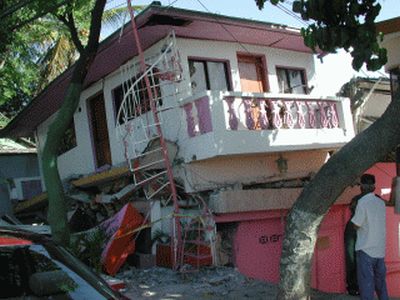
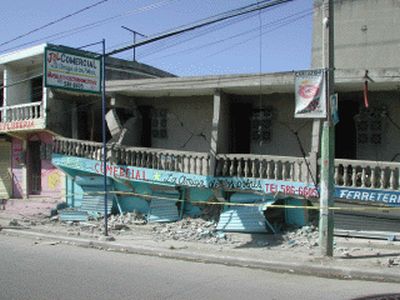
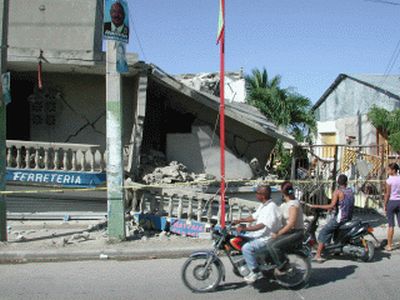
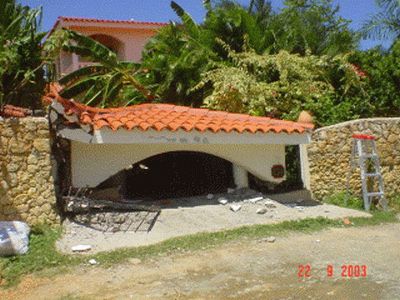
Recommended Emergency Products
The Earthquake Alarm (Amazon) can wake you up and alert you the moment a quake starts giving you more time to take cover.
*Operates off of a 9-volt battery.
*Loud distinctive alarm to wake you up.
*Can detect earthquakes miles away.
*Fully adjustable sensitivity setting. and more..(incluye instrucciones en espanol!)
I have heard many people use a detector and they say they work quite well. I recommend getting one if you live in any Earthquake prone area.
Another product that I read about is The Quake Escape
Ready America 70280 Emergency Kit, 2-Person, 3-Day Backpack. A backpack that keeps supplies at the ready. (Amazon)
*Sustains two people for three days
*Includes food, water, and emergency blankets
*One 33-piece first aid kit
NOAA Weather Radio and Solar Emergency Survival Device (Amazon)
*AM/FM Transmission
*Windup Power for Emergencies, Tornadoes, Hurricanes
*Micro USB Charger and Power Bank for Cell Phones and Electron
Weather Links – Earthquakes and Tsunamis
*The Dominican Republic Emergency Operations Center (COE). They now offer a downloadable App for emergency Alerts – Alerta COE.
Other instructions on how to prepare for an earthquake and other interesting web sites about earthquakes.
*ready.gov/earthquakes
*Acqweather, complete information on the weather in Dominican Republic.SPANISH
*Global Earthquake Monitor – list, news and maps of recent quakes worldwide.
*Create an Earthquake Emergency Handbook
*This is the Earthquake information from the Puerto Rico Seismic Network
*Earths view of Earthquake activity
*Quakes – Live Earthquakes Map and other interesting maps.
*Earthquake forecasting and hazard analysis.
*USGS Earthquakes Hazards Program has all the Earthquakes listed in the world for the last 7 days. The latest in USA and surrounding areas (including Dominican Republic – sometimes called Mona Passage) with an earthquake of Magnitude 2.5 or greater. All other areas of the world are listed when they have a quake with a Magnitude 4.0 or greater.







